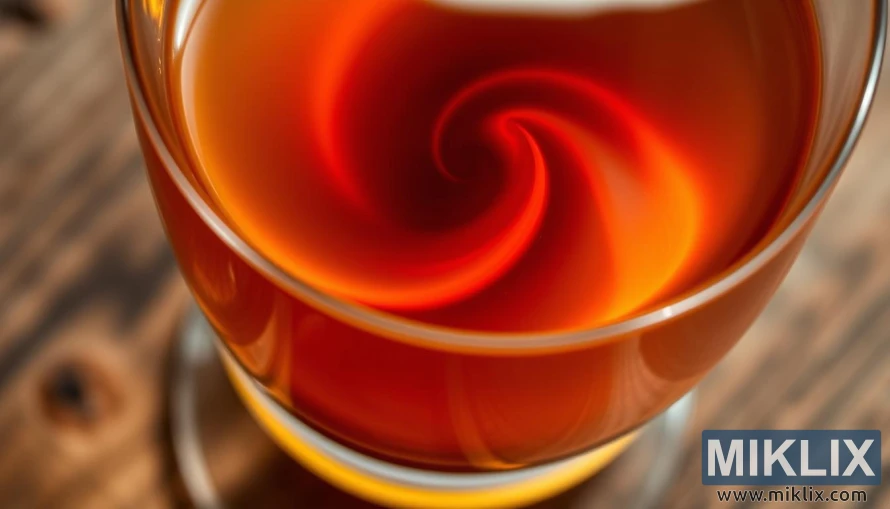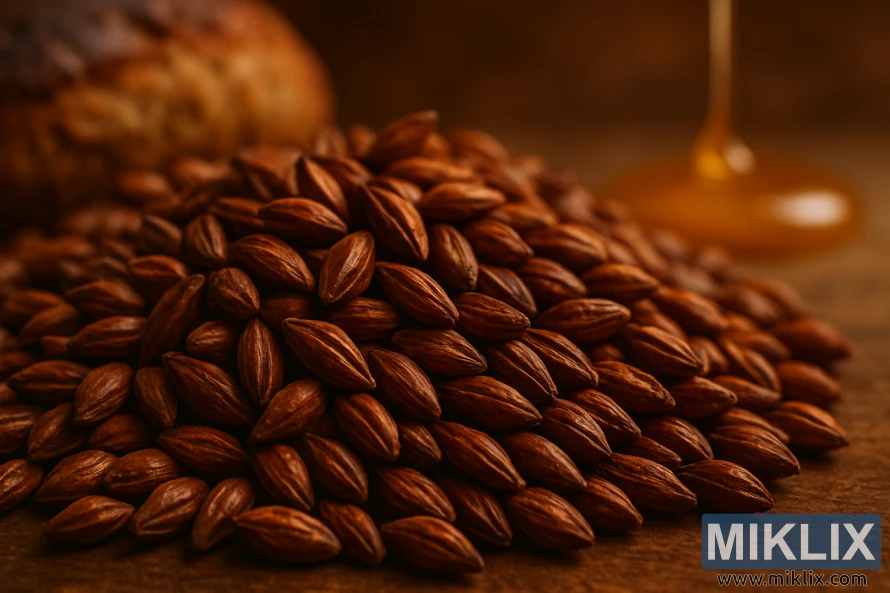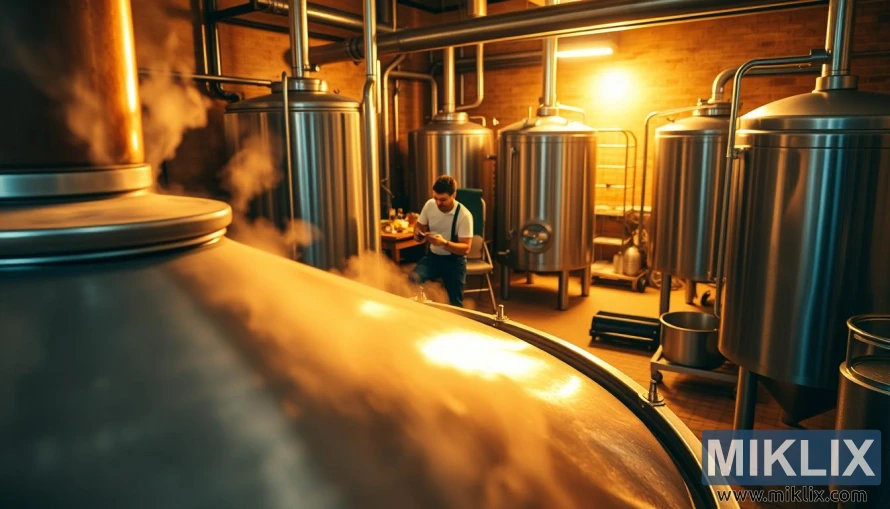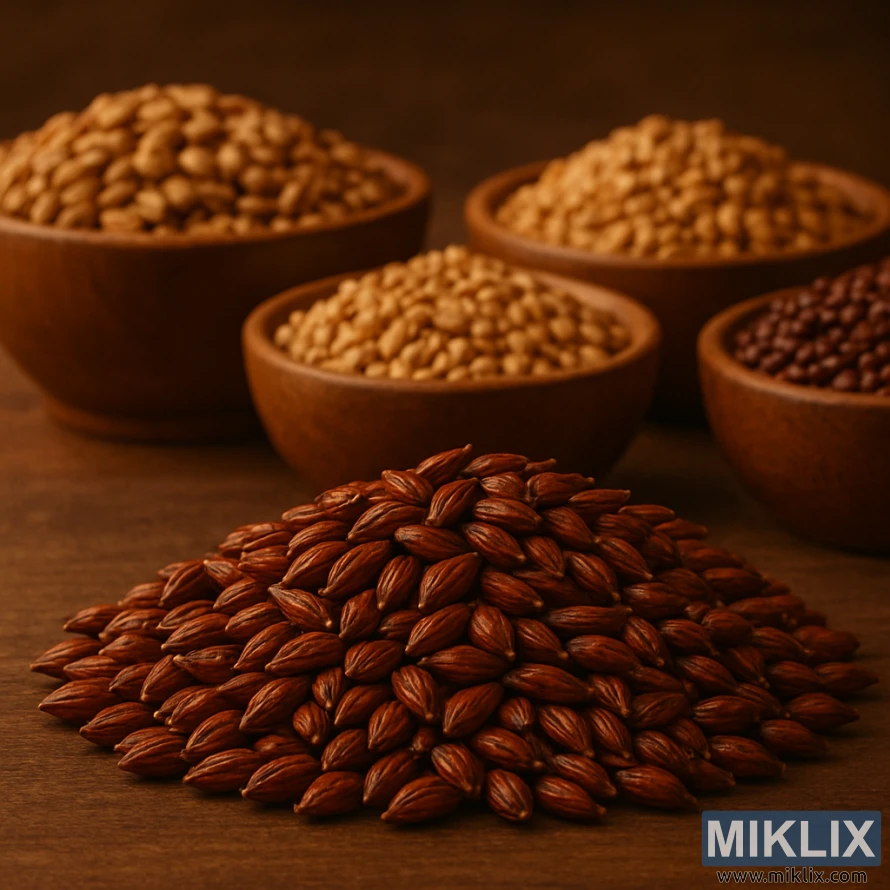Brewing Beer with Melanoidin Malt
Published: August 4, 2025 at 4:52:46 PM UTC
Using Melanoidin Malt in brewing beer introduces a rich, complex flavor profile. This malt is celebrated for its deep maltiness and hints of bread crust and honey. It's a favorite among brewers for these distinctive qualities. Brewers praise Melanoidin Malt for its unique taste, reminiscent of wine after fermentation. By adding this malt to their recipes, brewers can craft beers with profound, satisfying flavors.

Key Takeaways
- Melanoidin Malt adds intense maltiness to beer.
- It contributes notes of bread crust and honey.
- Brewing with Melanoidin Malt can create complex beer flavors.
- This malt is known for its wine-like fermented quality.
- Using Melanoidin Malt can enhance the overall flavor profile of beer.
Understanding Melanoidin Malt Fundamentals
Melanoidin Malt is celebrated for its deep flavor, making it a staple in many beer recipes. It's a specialty malt that adds complexity and depth to brews.
The making of Melanoidin Malt involves heating malted grains to a precise temperature. This enhances the Maillard reaction. This reaction occurs when amino acids and sugars meet heat, creating new flavors.
Unlike pale malts, which are lightly roasted, Melanoidin Malt is roasted at higher temperatures. This gives it a richer, more intense malt flavor.
Its unique characteristics make Melanoidin Malt perfect for brewers aiming for a robust malt profile. It enriches the beer's flavor and aroma, leading to a more complex drinking experience.
- Enhances malt flavor
- Contributes to beer complexity
- Used in various beer styles
Understanding Melanoidin Malt's role in brewing helps brewers appreciate its value. It guides them in making informed choices for their recipes.
Key Characteristics of Melanoidin Malt in Brewing
Melanoidin Malt significantly enhances beer's character, introducing flavors reminiscent of honey and a wine-like fermentation quality. It's highly valued for adding complexity and depth to a variety of beer styles.
The flavor profile of Melanoidin Malt is marked by intense maltiness and bread crust notes. Its aroma is rich and malty, enriching the overall sensory experience of the beer.
Proper use of Melanoidin Malt can boost beer's body and color, making it a key ingredient in brewing. Its unique traits are ideal for beer styles seeking a rich, malty flavor.
- Enhances beer complexity with its distinct flavor profile
- Contributes to a rich, malty aroma
- Adds depth and intensity to maltiness
Understanding Melanoidin Malt's key characteristics empowers brewers to craft unique, flavorful beers. These beers can differentiate themselves in the market.

The Chemistry of Melanoidin Malt Production
The Maillard reaction is key in creating melanoidins during malting. It's a non-enzymatic browning reaction between amino acids and reducing sugars when heated. This results in compounds with unique flavors, aromas, and colors.
Several factors influence the Maillard reaction. Temperature, moisture, and time are among them. Higher temperatures and longer times intensify the reaction, leading to more melanoidins. Yet, too much heat can spoil the flavors and colors.
Moisture content is also vital in the Maillard reaction. The right moisture levels are necessary for the reaction to occur without unwanted microbial growth. Achieving the perfect balance between temperature and moisture is essential for quality Melanoidin Malt.
By controlling these factors, brewers can fine-tune the malting process. This allows them to create Melanoidin Malt with specific characteristics. Understanding the chemistry behind melanoidin formation helps brewers optimize their malting. They can then achieve the desired flavors and colors in their beers.
- Temperature control is essential for managing the Maillard reaction.
- Moisture levels must be optimized to facilitate the reaction.
- Time is also a critical factor, as longer reaction times can lead to more intense flavors.
By carefully managing these factors, brewers can produce Melanoidin Malt. This malt enhances the complexity and depth of their beers.
Flavor Profile Analysis
Melanoidin Malt is known for its intense maltiness, bread crust notes, and hints of honey. It adds depth and complexity to beer, making it a favorite among brewers.
When used in brewing, Melanoidin Malt brings a rich and complex flavor profile. This includes:
- Rich maltiness that enhances the overall body of the beer
- Bread crust notes that add a toasted, baked quality
- Honey-like sweetness that balances out the maltiness
- A wine-like fermented quality that adds complexity
The sensory evaluation of Melanoidin Malt shows its ability to create unique and delicious flavors in beer. Brewers can use this malt to craft a variety of beer styles. From malty, sweet beers to complex, fermented brews, the possibilities are endless.
In descriptive analysis, the flavor profile of Melanoidin Malt is often associated with:
- Malty sweetness
- Toasted or baked flavors
- Fruity or wine-like notes
Understanding the flavor profile of Melanoidin Malt helps brewers better incorporate it into their recipes. This ensures they achieve the desired flavor characteristics in their brews.

Optimal Usage Rates in Different Beer Styles
When brewing with Melanoidin Malt, it's vital to grasp the optimal usage rates for various beer styles. The amount used greatly affects the beer's taste, adding maltiness, bread crust, and honey-like notes. This knowledge is key to achieving the desired flavor in your brew.
The right amount of Melanoidin Malt varies by beer type. For instance, in darker beers like bocks and dopplebocks, using 10-15% of Melanoidin Malt boosts the malty taste. On the other hand, for lighter styles like pale ales or lagers, a smaller amount (2-5%) is better to prevent overwhelming the other flavors.
Other factors like the desired flavor and brewing method also play a role. For example, to emphasize malty flavors, brewers might use more Melanoidin Malt. For a balanced taste, less is often better.
- For Munich Dunkel, use 5-8% Melanoidin Malt to enhance the malty, toasted flavors.
- In Oktoberfest/Märzen styles, 3-6% Melanoidin Malt can add complexity without overpowering the other malts.
- For Amber or Red Ales, 2-4% Melanoidin Malt can contribute to a balanced malt profile.
Understanding the optimal usage rates for Melanoidin Malt in different beer styles allows brewers to craft a wide variety of flavors. This knowledge enhances the overall character of their beer.
Brewing Techniques with Melanoidin Malt
Brewing with Melanoidin Malt demands a deep understanding of its unique characteristics. This specialty malt enhances beer's depth and complexity. Yet, achieving the desired results hinges on the right brewing techniques.
The mashing process is critical when using Melanoidin Malt. Aim for a mash temperature between 152°F and 155°F. This range activates enzymes, breaking down complex compounds. This results in a richer, more nuanced flavor.
The sparging process also plays a vital role. Use water at a temperature not too hot to avoid extracting unwanted tannins. A temperature of around 168°F is recommended. Ensure even distribution of sparge water for consistent extraction.
During boiling, Melanoidin Malt can enhance hop flavor and aroma. Add hops at different boil stages to balance bitterness, flavor, and aroma.
- Use Melanoidin Malt in moderation to avoid overpowering the beer with its intense maltiness.
- Experiment with different mash temperatures to find the optimal range for your specific recipe.
- Monitor the boil to prevent scorching, which can lead to off-flavors.
By mastering these techniques and tips, brewers can fully exploit Melanoidin Malt's capabilities. This leads to beers rich in flavor and complexity.

Impact on Beer Color and Body
The inclusion of Melanoidin Malt in brewing profoundly affects the beer's color and body. It contributes to the creation of melanoidins, compounds formed through the Maillard reaction. This reaction occurs when malt is heated during the malting process, involving amino acids and reducing sugars.
This process enriches the malt's color and flavor, influencing the beer's appearance and texture. The type of malt, brewing technique, and recipe are all critical in shaping the beer's final characteristics.
Using Melanoidin Malt in brewing results in a beer with a richer, more intense color and a fuller body. The melanoidins produced enhance the beer's complexity and depth. This makes Melanoidin Malt a key ingredient for specific beer styles.
- Melanoidin Malt enhances beer color through the formation of melanoidins.
- The Maillard reaction during malting affects the malt's color and flavor.
- Brewers can achieve a fuller body and richer color by incorporating Melanoidin Malt into their recipes.
Understanding Melanoidin Malt's impact on beer color and body allows brewers to make better decisions in their recipes. This leads to the creation of unique and delicious beers that highlight the malt's special qualities.
Complementary Malt Combinations
The art of combining Melanoidin Malt with other malts is key to crafting unique beers. By pairing Melanoidin Malt with complementary malts, brewers can create complex and rich flavor profiles. These enhance the overall character of their beers.
When selecting complementary malts, brewers should consider several factors. These include the type of beer being brewed, the desired flavor profile, and the brewing technique. For example, when brewing a bock or a dark lager, pairing Melanoidin Malt with Munich or Vienna malt can add depth and complexity to the beer's flavor.
- Pilsner malt for a balanced flavor
- Wheat malt for a refreshing, fruity twist
- Caramel malt for added sweetness and complexity
Experimenting with different malt combinations can help brewers develop unique recipes. This allows them to achieve the desired flavor profile. By understanding how different malts interact with Melanoidin Malt, brewers can unlock new possibilities for their beers.

Common Brewing Mistakes to Avoid
When brewing with Melanoidin Malt, several common mistakes can be easily avoided with the right knowledge. This specialty malt adds depth and complexity to beer. But, its unique characteristics require careful handling to achieve the desired results.
Mashing is a critical step in brewing with Melanoidin Malt. It involves mixing the malt with hot water to extract sugars. A common mistake is not maintaining the optimal temperature. The ideal temperature for mashing is between 152°F and 155°F. Temperatures outside this range can lead to an imbalance in the beer's flavor and body.
Sparging is another key step. It involves rinsing the grains with hot water to extract remaining sugars. A mistake to avoid during sparging is using water that is too hot. This can extract unwanted tannins from the grains, leading to a bitter taste. The ideal sparge water temperature is between 168°F and 170°F.
Boiling is also a critical step where mistakes can occur. One common error is not boiling the wort long enough. This can result in a beer that is not fully fermented. A minimum boil time of 60 minutes is recommended when brewing with Melanoidin Malt.
To avoid these common mistakes, brewers can follow a few key tips:
- Monitor the mashing temperature closely to ensure it stays within the optimal range.
- Use the correct sparge water temperature to avoid extracting tannins.
- Maintain a vigorous boil for at least 60 minutes to ensure complete fermentation.
By being aware of these pitfalls and taking steps to avoid them, brewers can successfully use Melanoidin Malt. This creates complex and delicious beers. Whether you're a novice or an experienced brewer, understanding Melanoidin Malt's nuances is key to unlocking its full flavor.
Recipe Development Strategies
Creating unique beer recipes with Melanoidin Malt demands a thorough grasp of its unique traits and how it blends with other ingredients. Known for its deep, malty taste and aroma, Melanoidin Malt enriches a variety of beer styles with depth and complexity.
When crafting recipes with Melanoidin Malt, brewers must weigh several elements. These include the beer type, the desired taste, and the brewing method. For instance, it's ideal for malty ales, complex lagers, or specialty brews like bocks or doppelbocks.
Here are some strategies for developing unique beer recipes with Melanoidin Malt:
- Experiment with different ratios of Melanoidin Malt to other malts to achieve the desired flavor profile.
- Blend Melanoidin Malt with other specialty malts, such as Munich or Caramel malts, for complex flavors.
- Optimize the extraction of Melanoidin Malt's characteristics by adjusting the brewing technique, including mashing and sparging.
- Pair Melanoidin Malt with other ingredients, like hops or yeast, to balance and harmonize flavors.
Some examples of unique beer recipes that highlight Melanoidin Malt's versatility include:
- A malty, caramel-flavored ale made with Melanoidin Malt and Caramel malts.
- A complex, malty lager crafted with Melanoidin Malt and Munich malts.
- A specialty bock brewed with Melanoidin Malt, dark malts, and specialty hops.
Commercial Beer Examples Using Melanoidin Malt
Melanoidin Malt is essential in brewing various commercial beers, adding distinct flavors. Many breweries depend on it for a rich, malty taste. This enhances the overall beer experience.
Several beer styles benefit from Melanoidin Malt, such as bocks, doppelbocks, and some Belgian ales. For example, German bock beers are famous for their intense maltiness. This is mainly due to Melanoidin Malt. Belgian ales also use it to deepen their flavor profiles.
- Weihenstephaner Hefe Weissbier, which uses Melanoidin Malt to enhance its wheat beer flavor.
- Einbecker Ur-Bock, a traditional German bock that relies on Melanoidin Malt for its characteristic maltiness.
- Chimay Blue, a Belgian ale that incorporates Melanoidin Malt to add complexity to its flavor profile.
The inclusion of Melanoidin Malt in these beers showcases its versatility. It significantly influences the final product. By studying how commercial breweries use it, brewers can craft their own unique beers.
Troubleshooting Your Melanoidin Malt Brew
To maximize Melanoidin Malt's benefits, it's essential to tackle common brewing problems. This specialty malt enhances beer with intense maltiness, bread crust, and honey notes. Yet, its use can sometimes introduce unexpected issues.
The type of equipment used significantly impacts brewing. The design of the mash tun and the material of the brewing kettle influence flavor extraction from Melanoidin Malt. It's critical to ensure your equipment matches the recipe and brewing method.
Common problems with Melanoidin Malt include overpowering flavors, uneven fermentation, and unexpected beer color. To solve these, brewers can tweak their mashing, sparging, and boiling methods. For instance, adjusting the mash temperature can control sugar and flavor extraction from Melanoidin Malt.
- Check the grist composition to ensure the right balance of malts.
- Monitor mash pH to optimize enzyme activity.
- Adjust sparging techniques to avoid extracting unwanted tannins.
Understanding Melanoidin Malt's characteristics and its interaction with other ingredients is key. This knowledge allows brewers to effectively troubleshoot common issues. It enables the creation of unique, delicious beers that highlight Melanoidin Malt's full range.
Conclusion
Brewing with Melanoidin Malt opens up a world of possibilities for beer enthusiasts. It allows brewers to enhance the flavor and character of various beer styles. By grasping the malt's characteristics, production, and optimal usage, brewers can unleash their creativity in recipes.
Key points to remember include its rich, malty flavor and its effect on beer color and body. Balancing it with other malts is critical. By avoiding common mistakes and experimenting, brewers can craft high-quality beers that highlight Melanoidin Malt's versatility.
Commercial beers show Melanoidin Malt's value in a range of styles, from bocks to amber ales. By applying the knowledge from this article, brewers can confidently use Melanoidin Malt. This will allow them to explore new flavors in their brewing.
Further Reading
If you enjoyed this post, you may also like these suggestions:
